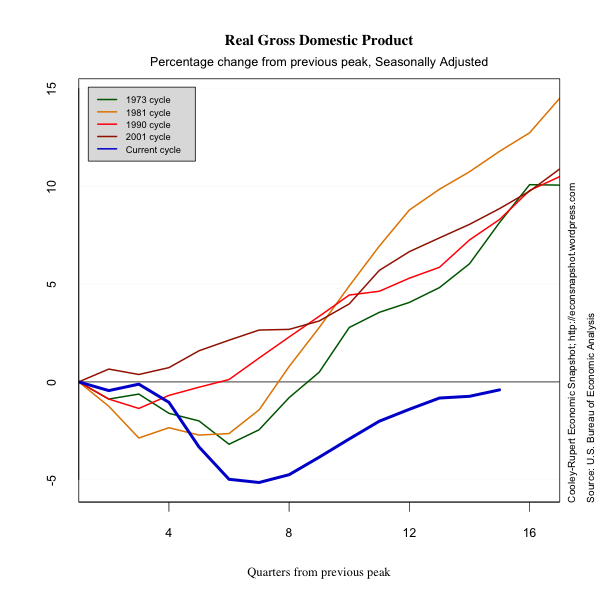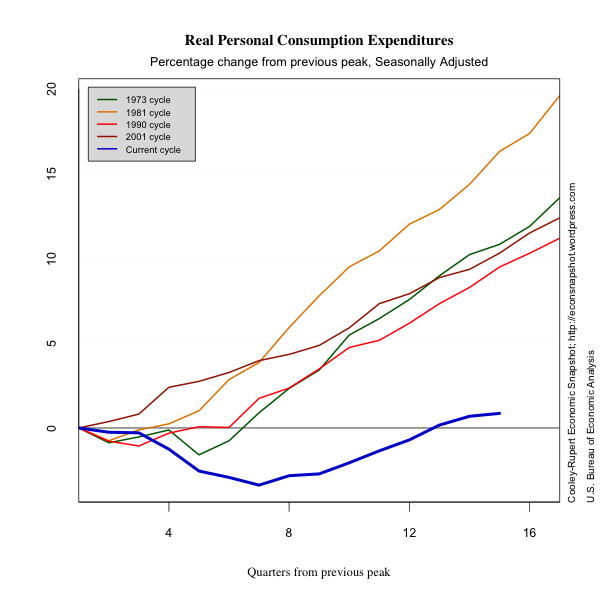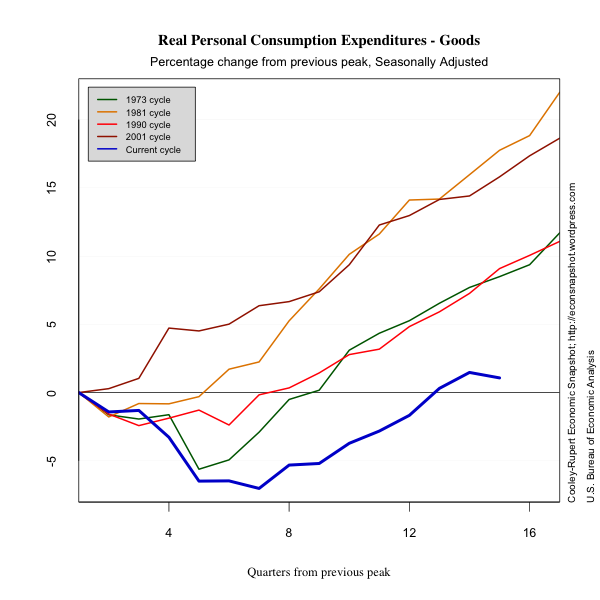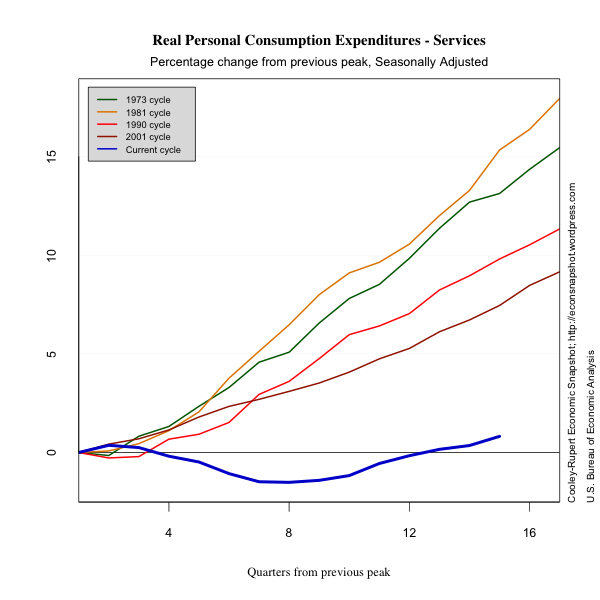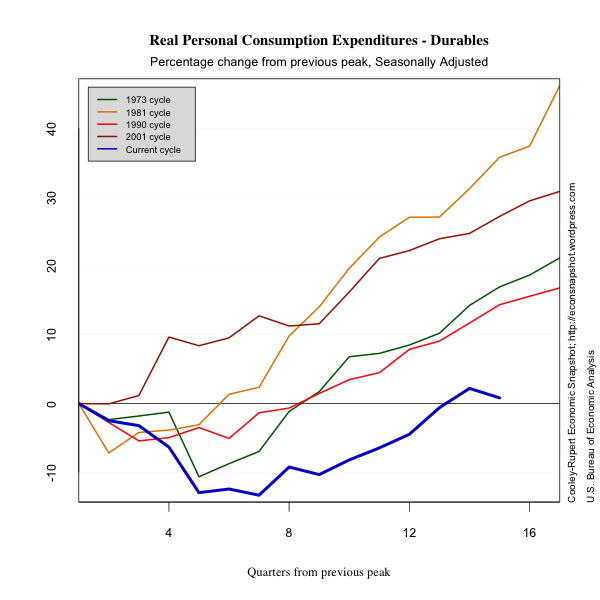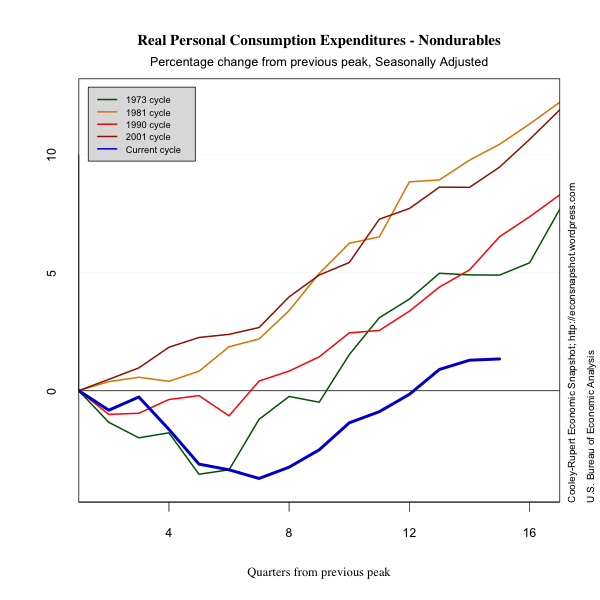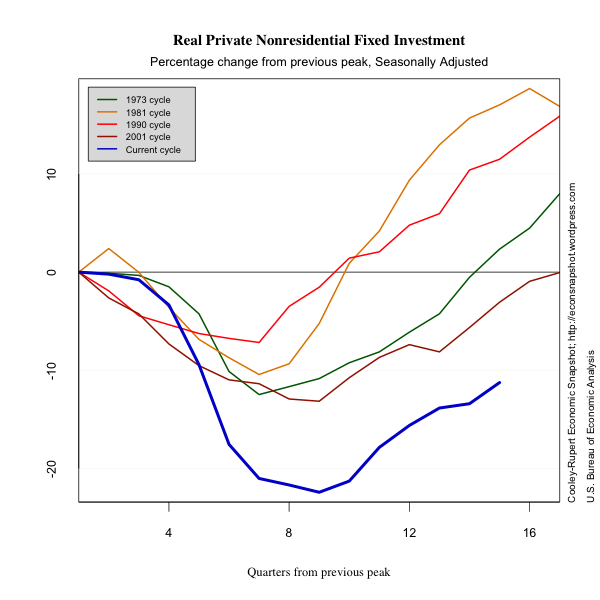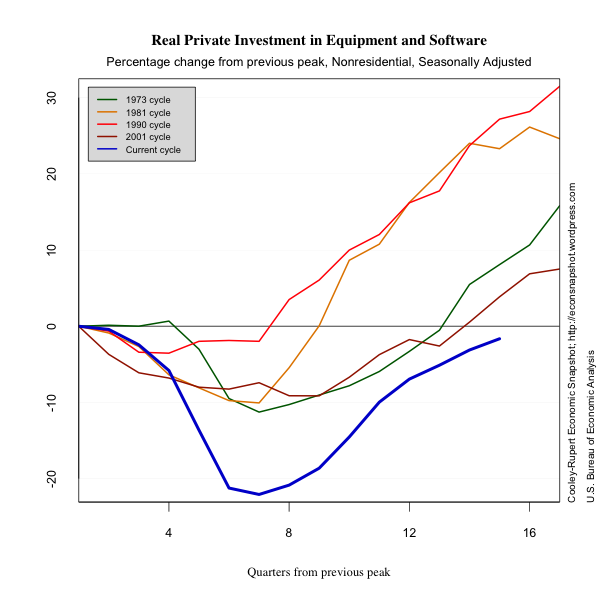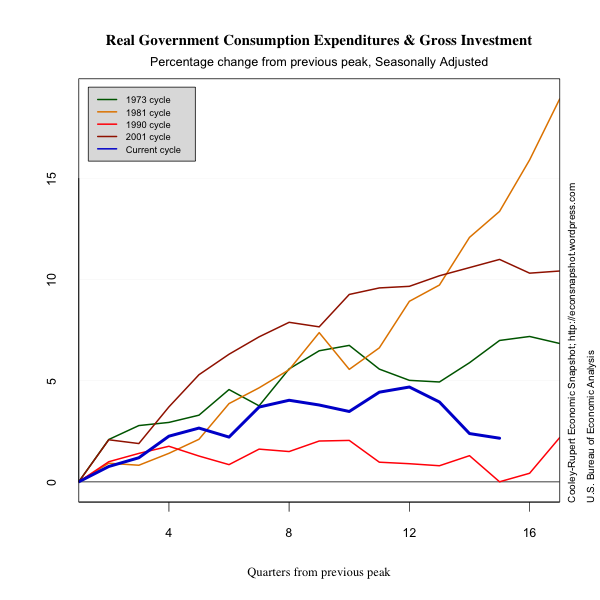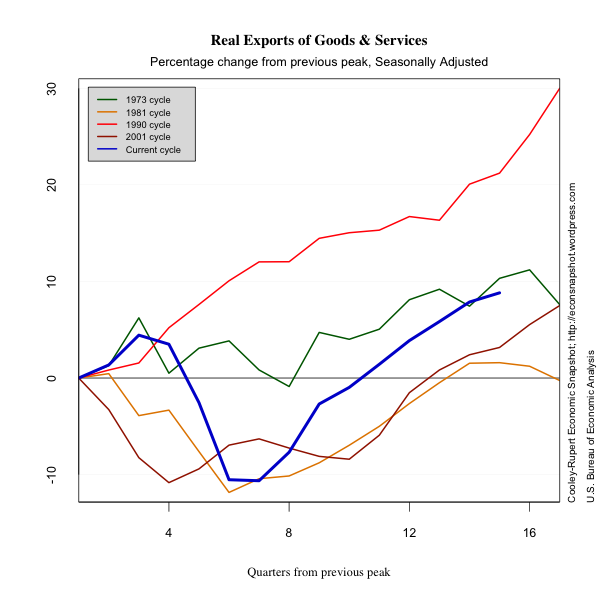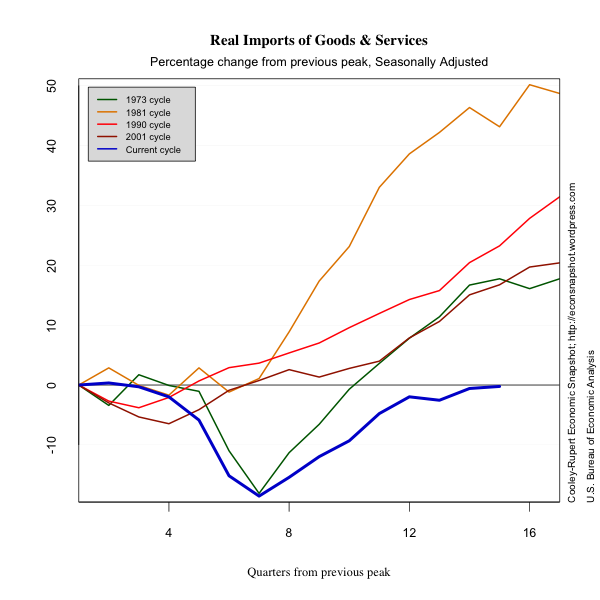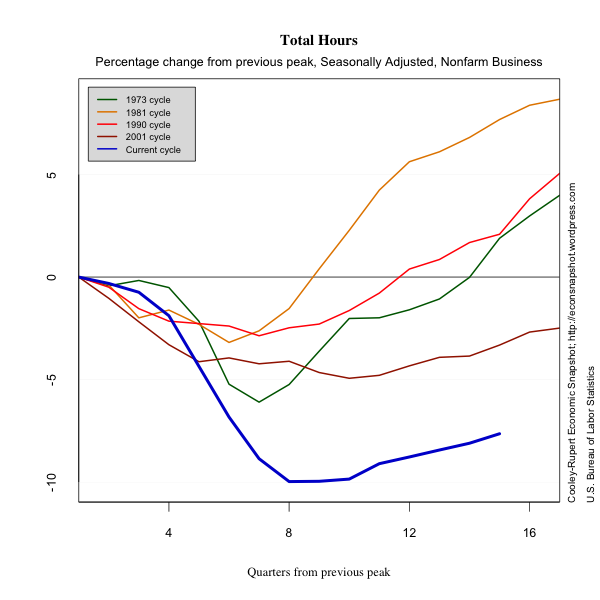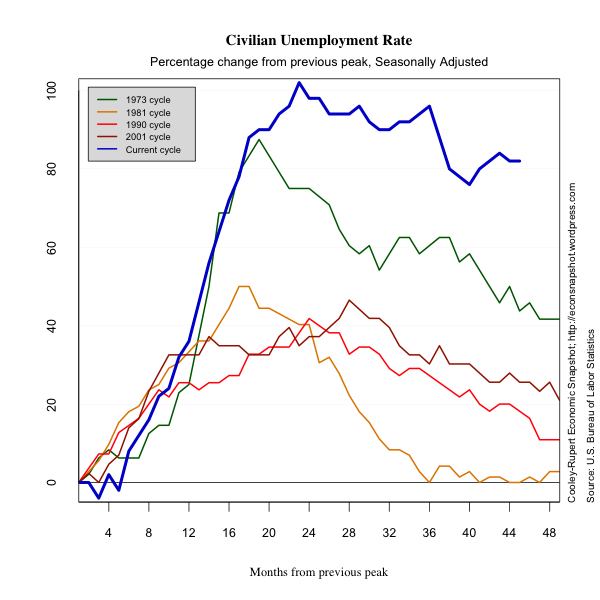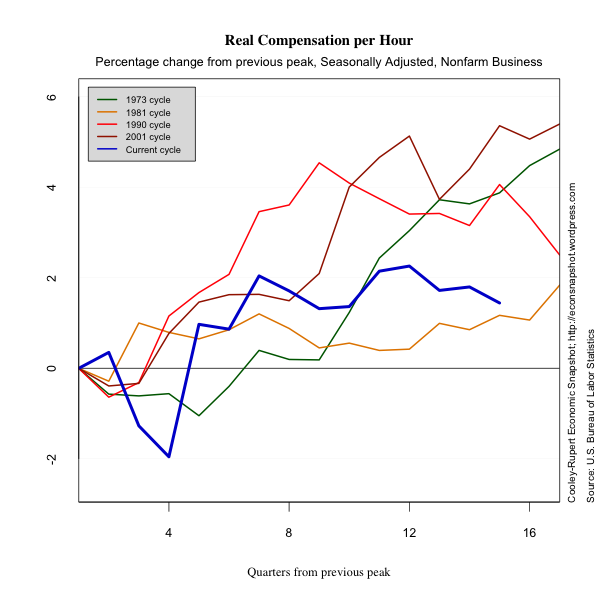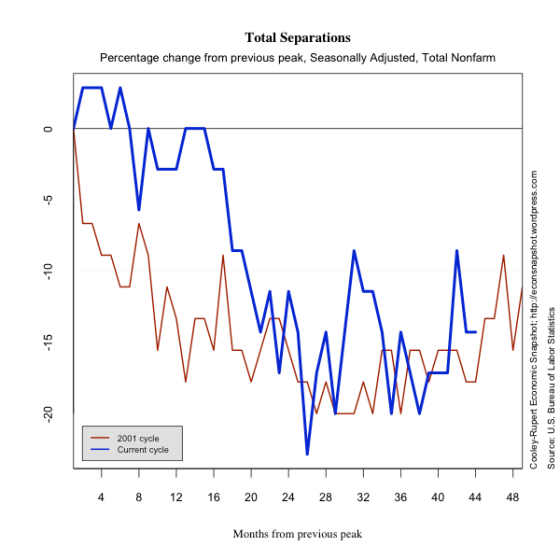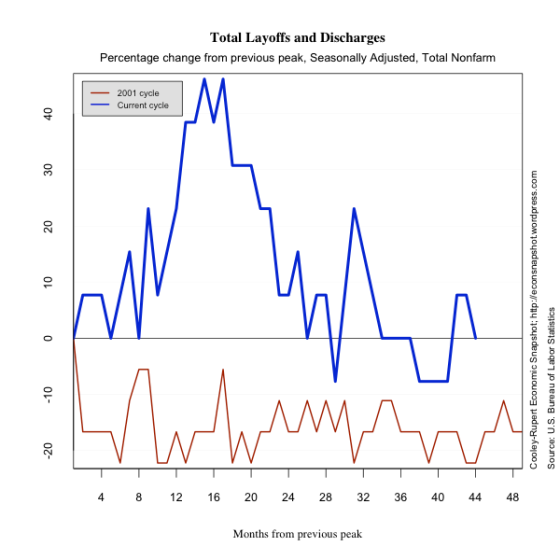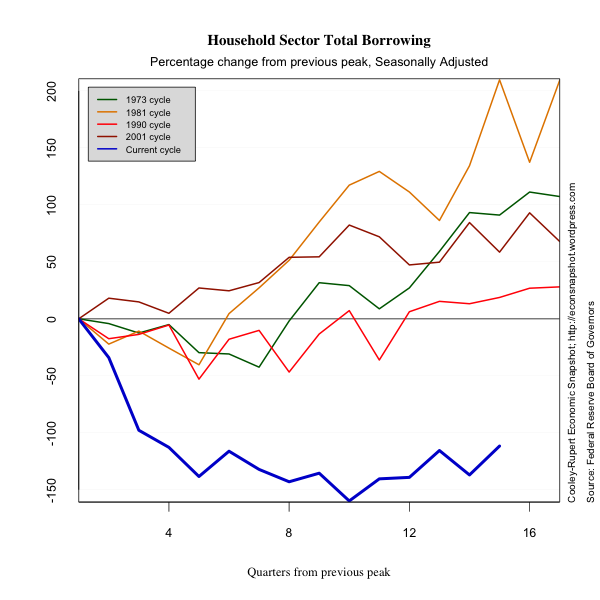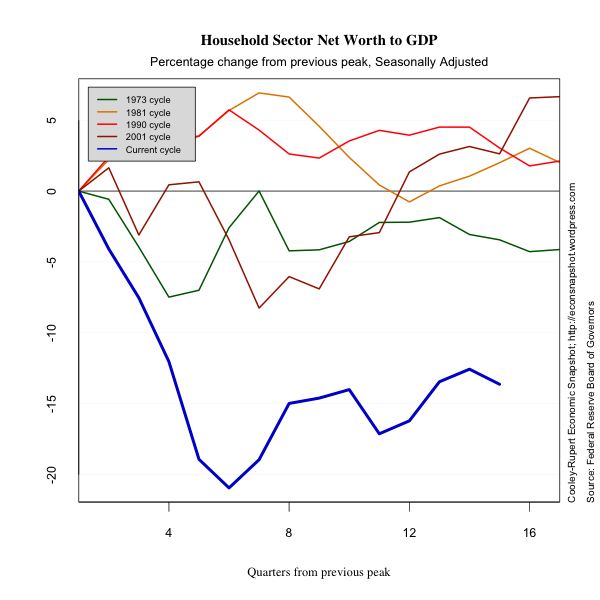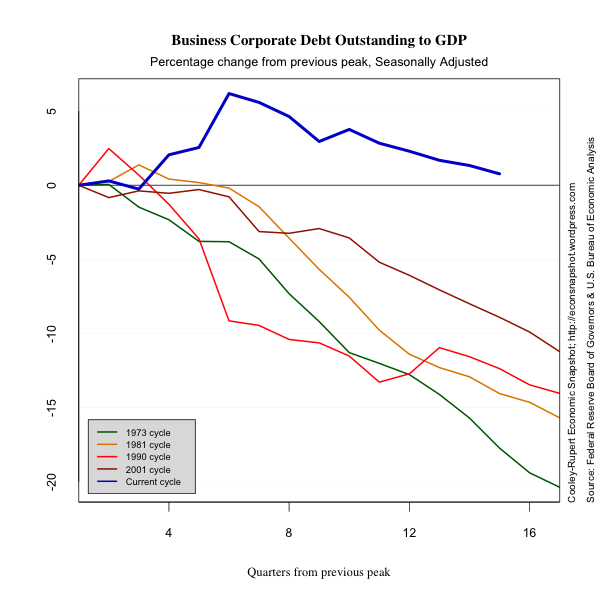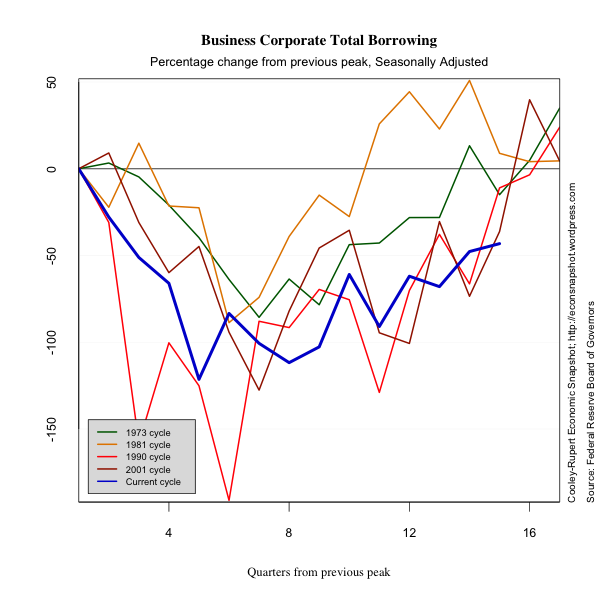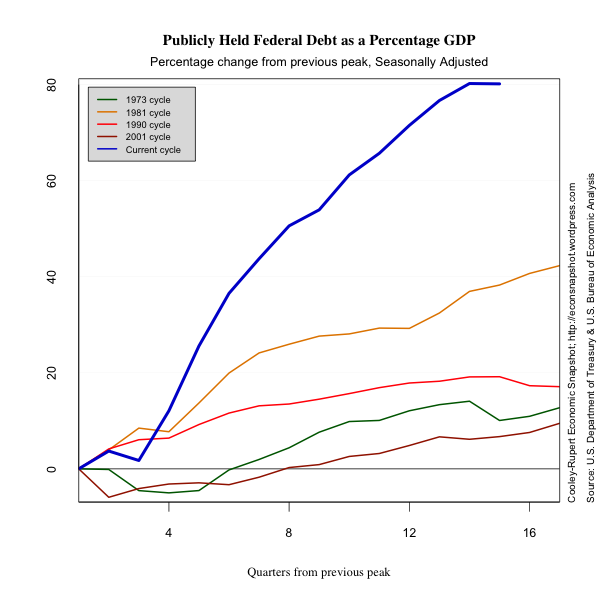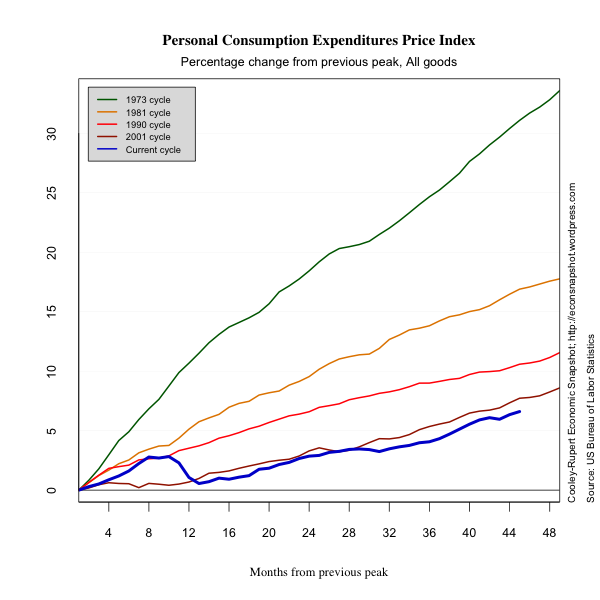Welcome to the Cooley-Rupert Economic Snapshot–our view of the current economic environment. Click here to go to the latest snapshot in one pdf document. Or, read on….
Introduction
This is latest version of our snapshot of the U.S. Economy based on the most recent data releases from the Bureau of Economic Analysis, the Bureau of Labor Statistics, and the Federal Reserve. As in previous snapshots we present the data in a way that we find particularly useful for assessing where we are in the business cycle and tracking the U.S. economic recovery. The paths of all the series presented are plotted relative to the their value at the peak of the
respective business cycles. We use the business cycle dates identified by the \textbf{National Bureau of Economic Research}. We present the data in four sections. The first summarizes the path of Gross Domestic Product and its components. In this post we take a deeper look at Investment and its component parts. This makes clear where the real problems for the recovery lie. The next section summarizes the labor market and its important indicators.
Here too we take a deeper dive than in our earlier post. Specifically we look at the behavior of aggregate hours of work and the duration of
unemployment. These present a depressing indication of how severe this recession is. The third section shows the activity in credit markets and the final
section summarizes the features of industrial production and inflation.
Does This Look Like A Recovery?
The most recent GDP numbers include the third revision of second quarter numbers. They continue to bear witness to the severity of this recession but second quarter growth turns out to have been slightly stronger than the preliminary estimates suggested. People who have worried about the prospect of a double-dip recession should take comfort from the fact that GDP is gradually recovering and that consumption has recovered to the level of its previous peak.
Gross Private Domestic Investment also shows signs of recovery, but there is one glaring problem. Private Residential Fixed Investment continues to be completely stagnant, bouncing along at a level that is 40% below the previous peak. Let’s think about what that means. GDP is roughly $15 trillion and Gross Private Domestic Investment is roughly $1.9 trillion or 12.6% of GDP. Private Residential Fixed Investment has fallen by more $300 billion since the business cycle peak and nearly $500 billion from its own peak. Since there is currently no compelling scenario under which residential investment is likely to recover this will continue to drag down the economy. In no other post 1970 recession did it fall so far and continue to stagnate nearly four years since the recession began. The last time residential investment was this low was in 1996 when GDP was slightly more than half what it is now. Investment in Equipment and Software continues to improve but it would have to be nearly a third larger to counter the decline in residential investment. Exports and Imports are evolving
in a way that is typical for previous recessions
The Ongoing Labor Market Disaster
Back in 2001, the labor market was quite unresponsive, leading to the moniker, The Jobless Recovery. Unfortunately, the depth and length of the current experience in the labor market is far worse, what will we call this one?
If one only looked at the labor market it would be hard to conclude that we are experiencing a recovery. Rather, it suggests an economy that is bumping along at the bottom of a business cycle trough. It is, perhaps, the primary testament to the severity and longevity of this recession.
As we noted in a previous post, the dating of business cycles by the NBER is based on a mixture of evidence that often includes reference to the labor market. Indeed, when the NBER dating committee dated the beginning of this past recession, they made it clear that the labor market was a key variable in their decision, as can be seen here. However, when the committee announced the trough there was no mention of the labor market, which has not shown any signs of recovery. Indeed, the paths of the employment/population ratio and the labor force participation rate make the strongest case for concern about a double dip recession.
In this post we take a deeper look at the labor market, including data on Aggregate Hours of work and the duration of unemployment. Aggregate Hours captures changes in both the extensive margin of labor force adjustment (employment), and the intensive margin (hours of work). Many believe this offers a more accurate picture of the economy …and the picture is grim. The data on the duration of unemployment is particularly discouraging.
We also include data from JOLTS, the Job Openings and Labor Turnover Survey. These show some more refined features of the labor market and permit comparison to the 2001 business cycle. What stands out in these data is that, while separations look similar to the 2001 cycle, this masks the extraordinarily abrupt increase in layoffs and discharges and the sharp decline in quits.
Credit Markets
Credit markets continue to show the after-effects of the tremendous increase in leverage the took place prior to the 2007-2009 crisis. Households are continuing to reduce their debt and at an increasing rate. Corporate sector borrowing continues to improve and is following a path that is typical of prior recessions. The big story in credit markets is the dramatic shift of leverage to the public sector. Public sector debt outstanding is reaching levels unprecedented in the post-war economy.
Industrial Production and Inflation
In this section we present some plots of miscellaneous series that reflect other characteristics of this business cycle. The decline in industrial production is dramatic. There is no evidence of inflation or deflation.
Glossary
Compensation includes accrued wages and salaries, supplements,
employer contributions to employee benefit plans, and taxes.
Consumer Price Index measures the price paid by urban consumers
for a representative basket of goods and services. Prices are
collected from 87 urban areas and from approximately 23,000 retail and
service establishments.
Debt Outstanding measures the current level debt owed on credit market
instruments. Credit market instruments include open market paper,
Treasury securities, agency and GSE-backed securities, municipal
securities, corporate and foreign bonds, bank loans, mortgages, and
consumer credit.
Durables are goods that have an average useful life of at least 3
years.
Employment Population Ratio is the ratio of the number of
civilians in the labor force to the total civilian population.
Exports consist of goods and services that are sold or
transferred by U.S. residents to foreign residents.
Goods are tangible commodities that can be stored or inventoried.
Government Consumption Expenditures and Gross Investment measures
current consumption expenditures by the government in order to produce
goods and services to the public and investment in structures and
equipment and software.
Gross Private Domestic Investment measures additions and
replacements to the stock of private fixed assets without deduction of
depreciation.
Imports consist of goods and services that are sold or
transferred by foreign residents to U.S. residents.
Industrial Production Index measures real output of
manufacturing, mining, and electric and gas utilities industries.
Job Openings or Vacancies are all positions that are open (not
filled) on the last business day of the month.
Labor Force is defined as the number of unemployed persons plus
the number of employed persons.
Labor Force Participation Rate is the ratio of unemployed persons
to the number of persons in the labor force.
Net Worth equals to total assets minus total liabilities. Assets
include owner-occupied real estate, consumer durables, and equipment
and software owned by nonprofit organizations.
Nondurables are goods that have an average useful life of less
than 3 years.
Nonresidential Fixed Investment measures investment by businesses
and nonprofit institutions in nonresidential structures and in
equipment and software.
Personal Consumption Expenditures measures the value of goods
and services purchased by households, nonprofit institutions that
primarily serve households, private non-insured welfare funds, and
private trust funds.
Residential Fixed Investment measures investment by businesses
and households in residential structures and equipment, primarily new
construction of single-family and multifamily units.
Services are commodities that cannot be stored or inventoried and
that are usually consumed at the place and time of purchase.
Total Borrowing measures the flow of new credit market
liabilities during the period. Credit market liabilities include open market paper,
Treasury securities, agency and GSE-backed securities, municipal
securities, corporate and foreign bonds, bank loans, mortgages, and
consumer credit.
